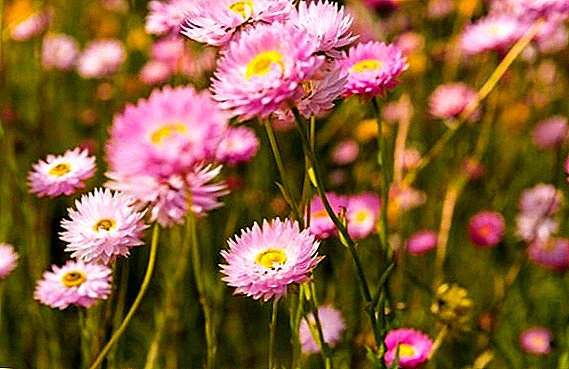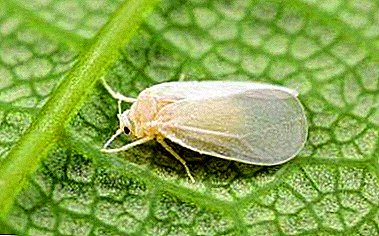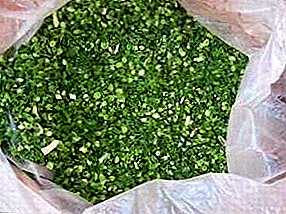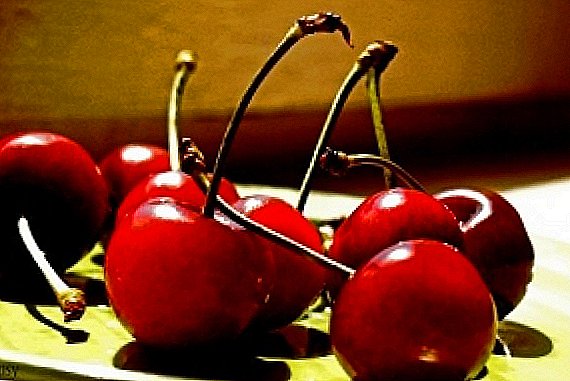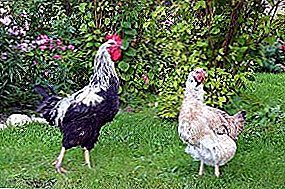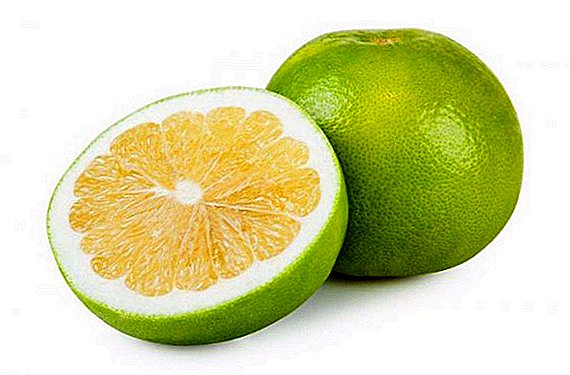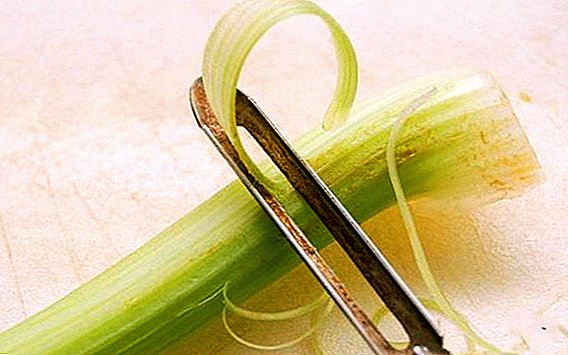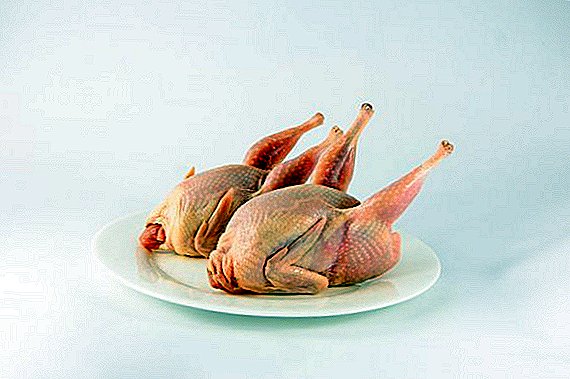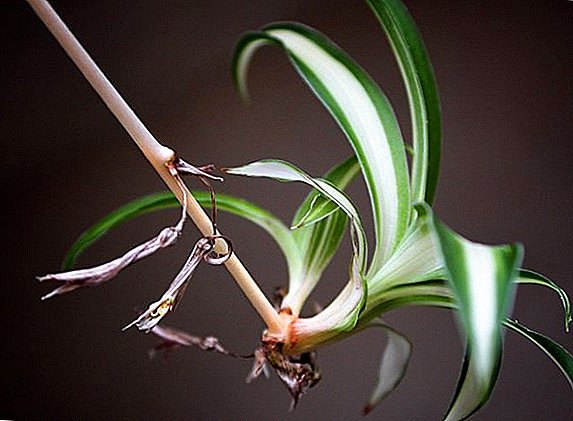 Chlorophytum crested - one of the most popular plants in apartments and offices.
Chlorophytum crested - one of the most popular plants in apartments and offices.
Due to his unpretentiousness and disease resistance, he won recognition among novice gardeners.
In this article we will describe how to properly care for a flower, and consider its useful properties.
Description of the species
Homeland chlorophytum - South Africa. The name he owes to his green leaves, because "Chlorophytum" is translated from Latin as "green plant". The name is widespread among the people. spider.
In nature, there are several dozen species of this plant, but the most popular of them is chlorophytum crested. The name of the flower received on the basis of appearance. Narrow leaves are collected in long bunches, "tuft", which rise above the ground.  In the process of growth in the "spider" appear arrows with "kids" at the ends, which can later be rooted. The height of the chlorophytum is no more than 15-25 cm, but its leaves exceed the length of the flower several times and reach 60 cm.
In the process of growth in the "spider" appear arrows with "kids" at the ends, which can later be rooted. The height of the chlorophytum is no more than 15-25 cm, but its leaves exceed the length of the flower several times and reach 60 cm.
Did you know? Chlorophytum cleans the room air more efficiently than many modern special technical devices.
Growing conditions
Caring for chlorophytum crested easily implemented at home. The main thing is to follow some rules.
Lighting
Chlorophytum perfectly adapted to the external environment and quite unpretentious in the matter of lighting. However, the bright sun will contribute to the drying of the soil, resulting in fading of the leaves.
But a strong shadow will lead to the fact that the leaves will lose brightness due to insufficient amount of ultraviolet radiation. Therefore, the "spider" basically should be in the shade, limited to the direct exposure to the sun for no more than two hours a day. In the summer it is recommended to take the flower to the air. 
Important! The best way to grow chlorophytum in the west, north or east window. It is here that he will receive protection from direct exposure to the sun, without being short in the amount of light.
Air temperature and humidity
Although the flower easily tolerates changes in temperature, it will be most appropriate to grow it at a temperature of from +12 to +25 ° C. In the summer, in order to maintain the necessary humidity, it is impossible to do without frequent spraying. In winter, the temperature in the room is not allowed lower than +10 ° C.
Optimum soil
"Spider" does not need special soil. It will fit loose and light neutral ground. Ground substrate can be made independently. It is necessary to take the humus soil, turf, leaf soil and sand (in the ratio 2: 2: 2: 1). In the absence of the humus component, it is replaced by turf ground.
The roots of the Crested Chlorophytum expand strongly, so it is necessary to plant it in a wide pot, pouring a drainage from a pebble or broken brick to the bottom.
How to propagate the plant
The easiest way for reproduction of crested chlorophytum is in the abandonment of "babies" on the mother plant before the emergence of its own roots. A separate pot is placed near the mother plant, where it is necessary to plant the "babies", in no case cutting them off.
The separation of the young plant from the parent occurs after the appearance of new leaves. Some growers tear off the "baby", put in the water before the roots grow at least 2 cm long, then plant it in a pot.
Important! In the spring, the vegetation of Chlorophytum crested occurs, so it is recommended to replant it during this period.It is also possible to propagate the "spider" by seeds, but this is quite laborious. Another way - divide bush during transplant. This helps to improve the plant, especially when it is overgrown with roots.

Care for the "spider"
Chlorophytum is an energyless plant, and indoor care at home is not complicated.
Watering
Chlorophytum is notable for its love of moisture. It should be watered 2-3 times a week with separated or boiled water. In winter, the amount of water must be reduced, and during the rest of the year abundant watering is required. It is not recommended to “flood” or “dry” the plants; this can lead to the tips of the leaves becoming brownish.
In the absence of regular watering, chlorophytum forms root thickenings, due to which it easily adapts to the lack of moisture.
Did you know? According to research scientists, in 24 hours one adult plant cleans the room from all bacteria and organic harmful substances by almost 100%.Chlorophytum must be sprayed. It has rather narrow leaves with a hollow in the middle, in which dust periodically accumulates. From time to time it is necessary to clean the leaves with a damp cloth.

Fertilizer
Fertilizing the "spider" should be once a week from May to August, during this period its most active growth occurs. Used for this complex fertilizer. Top dressing is necessary for a weakened maternal plant, from which fast-growing "babies" take power, because of which it can wither without proper care.
Sansevieria, tradescantia, cactus, euphorbia, hoya, zamiokulkas, spathiphyllum, hibiscus, zygocactus will not require special care.
Pruning
Chlorophytum crested does not need special pruning, but to make the flower look beautiful, dry and darkened leaves are cut with scissors. In order not to harm the plant, cut the leaves only from the outside of the rosettes, without touching the inside.
Transfer
Chlorophytum roots are thick and strong, have oblong tubers. They grow quickly, so every two to three years the flower should be transplanted into a larger pot. During transplantation large bushes are divided by cutting with a knife. Before this procedure it is necessary to water the soil abundantly.
Possible difficulties and illnesses
Chlorophytum is distinguished by its high resilience; diseases for it are an infrequent phenomenon. They are not afraid of pests, sometimes the appearance of aphids. Wiping the plant with a cotton swab moistened with warm water and then spraying with a diluted insecticide will help.
You can also highlight some of the problem points in chlorophytum, which can be solved by changing the scheme of care, namely:
- Drying out on the tips of the leaves usually occurs due to insufficiently moist soil or too hot and dry air. To solve this problem, you need to increase watering and sprinkle the "spider" with water at room temperature.
- Brown spots on the tips of the leaves appear due to damage or nutritional problems of the soil. The first step is to remove the damaged areas and fertilize the soil at least once a week.
- To pallor and lethargy Leaf leads too warm air and insufficient lighting. It is recommended to rearrange the flower closer to the window and air the room more often.

Few of the beneficial properties
The main beneficial property of chlorophytum crested is the absorption of bacteria, toxins that are released from synthetic materials, and air purification. It also neutralizes nitrogen oxides, which are caused by gas burning, so it is often put in the kitchen. When activated carbon is added to the soil with a flower, there is a marked increase in its cleaning properties.
Among the popular indoor plants useful properties have aloe, geranium, laurel, Kalanchoe, chrysanthemums, cactus, yucca, sansevieria.
Chlorophytum crested is not for nothing is popular with gardeners, because with its beauty, it is quite unpretentious. With the observance of simple rules of care, chlorophytum will for a long time please with its appearance and benefit.


